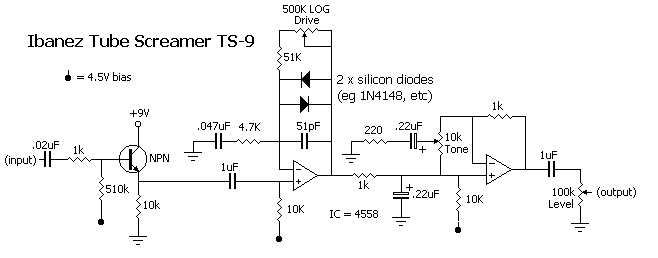Hello fellows,
I am designing my own distortion pedal (based around the Tube Screamer). But I have this question about biasing: In the original schematic of the TS (as well as any other guitar pedal whose schematic I found), the op-amp feedback network, the input transistor's base and the output pot are biased to 1/2 U.. which seems reasonable.. but the input and output signal grounds, as well as any other ground in the schematic (filters, RC networks, etc.) are at 0V... Why is that? Shouldn't all grounds be connected to a common point with a potential of U /2.. That's what I've seen on countless battery powered headphones amps and other devices.... Please explain why is that.
Regards

I am designing my own distortion pedal (based around the Tube Screamer). But I have this question about biasing: In the original schematic of the TS (as well as any other guitar pedal whose schematic I found), the op-amp feedback network, the input transistor's base and the output pot are biased to 1/2 U.. which seems reasonable.. but the input and output signal grounds, as well as any other ground in the schematic (filters, RC networks, etc.) are at 0V... Why is that? Shouldn't all grounds be connected to a common point with a potential of U /2.. That's what I've seen on countless battery powered headphones amps and other devices.... Please explain why is that.
Regards

The grounds don"t change , 0v is still ground and +9v is still +9v , but the input signal has to be biased to 1/2 supply so it has a voltage referance so the signal can swing positive and negitive in relation to it .....
Don"t think of the 1/2 supply as a ground , think of it as a voltage referance ....
Most all Single supply opamp circuits use a Voltage referance ....
I hope I explained that right .....
Don"t think of the 1/2 supply as a ground , think of it as a voltage referance ....
Most all Single supply opamp circuits use a Voltage referance ....
I hope I explained that right .....
The grounds don"t change , 0v is still ground and +9v is still +9v , but the input signal has to be biased to 1/2 supply so it has a voltage referance so the signal can swing positive and negitive in relation to it .....
Don"t think of the 1/2 supply as a ground , think of it as a voltage referance ....
Most all Single supply opamp circuits use a Voltage referance ....
I hope I explained that right .....
I think you did. But it's important to see that it is in fact a Unipolar supply: we aren't trying to go for a bipolar supply where the middle of the divider is ground, it's the other way around, we build a unipolar circuit and therefore must bias the opamps (and transistors) to a more positive potential.
Now, I hope I haven't confused you. Funny because I was understanding the same as you at first.
the input transistor's base and the output pot are biased to 1/2 U..
OK, for a start the output pot is NOT biased to 1/2 U. It's decoupled by a cap, the DC voltage is at ground.
The input transistor's base is biased to 4.5V so that there's some standing current in the transistor otherwise at best there'd only be conduction in the transistor when the input signal exceeded ~0.6V
but the input and output signal grounds, as well as any other ground in the schematic (filters, RC networks, etc.) are at 0V... Why is that? Shouldn't all grounds be connected to a common point with a potential of U /2..
No, the grounds should all be at 0V, if they were at 4.5V they'd all be at the same potential as the signal path, which would defeat the point of biasing IT to 4.5V.
That's what I've seen on countless battery powered headphones amps and other devices....
No, you haven't.
w
Hi,
Ground is ground for signals with split supply.
With a single supply all signals are referenced to 1/2 the supply.
Ground is still ground and capacitor coupling removes this offset.
You have not seen "countless examples" as you describe, however
the 1/2 supply point is effectively the same as the split ground point.
For the split case coupling capacitor capacitors are optional.
rgds, sreten.
In your diagram only two of the ground points need to be ground,
the other three could be connected to the 1/2 supply point, but
its better to have a a strong DC bias across electrolytics.
Ground is ground for signals with split supply.
With a single supply all signals are referenced to 1/2 the supply.
Ground is still ground and capacitor coupling removes this offset.
You have not seen "countless examples" as you describe, however
the 1/2 supply point is effectively the same as the split ground point.
For the split case coupling capacitor capacitors are optional.
rgds, sreten.
In your diagram only two of the ground points need to be ground,
the other three could be connected to the 1/2 supply point, but
its better to have a a strong DC bias across electrolytics.
Last edited:
Hi,Hello fellows,
I am designing my own distortion pedal (based around the Tube Screamer). But I have this question about biasing: In the original schematic of the TS (as well as any other guitar pedal whose schematic I found), the op-amp feedback network, the input transistor's base and the output pot are biased to 1/2 U.. which seems reasonable.. but the input and output cheap essay tool signal grounds, as well as any other ground in the schematic (filters, RC networks, etc.) are at 0V... Why is that? Shouldn't all grounds be connected to a common point with a potential of U /2.. That's what I've seen on countless battery powered headphones amps and other devices.... Please explain why is that.
Regards
In case you are interested in the details, here's an informative guide (article) with schemes and graphics that show how Tube Screamer TS808 by Ibanez works. ElectroSmash article - ElectroSmash - Ibanez Tube Screamer
P.S.: didn't mean to bump that much. Perhaps someone needs this info (I found it in one of the forgotten forum archives).
Last edited:
I hope you don´t mean "gone" literallyDarn, the OP is probably gone.
As in:

Sometimes we are left wondering. Over the years, once or twice a long-time frequent contributor to a forum I belonged to has suddenly stopped posting. And we don't know if he/she is okay, or something bad happened.I hope you don´t mean "gone" literally
One time it turned out to be a sudden and severe heart-attack. I found out purely by chance that time, because a friend or family member logged into the account of the person who had been afflicted, and wrote a post to let other forum members know what had happened.
I still don't know how that ended - whether he recovered, or not. We never heard from that account again, so I suspect the worst. But I hope he recovered, and just lost interest in the topic of that particular forum - heart attacks can be pretty life-changing as far as priorities go.
-Gnobuddy
- Status
- This old topic is closed. If you want to reopen this topic, contact a moderator using the "Report Post" button.
- Home
- Live Sound
- Instruments and Amps
- Guitar pedal - biasing - why?